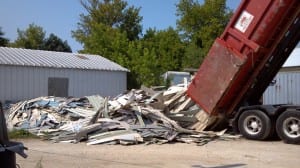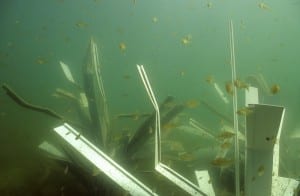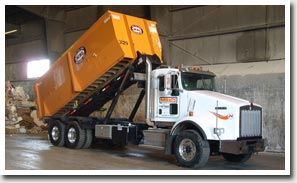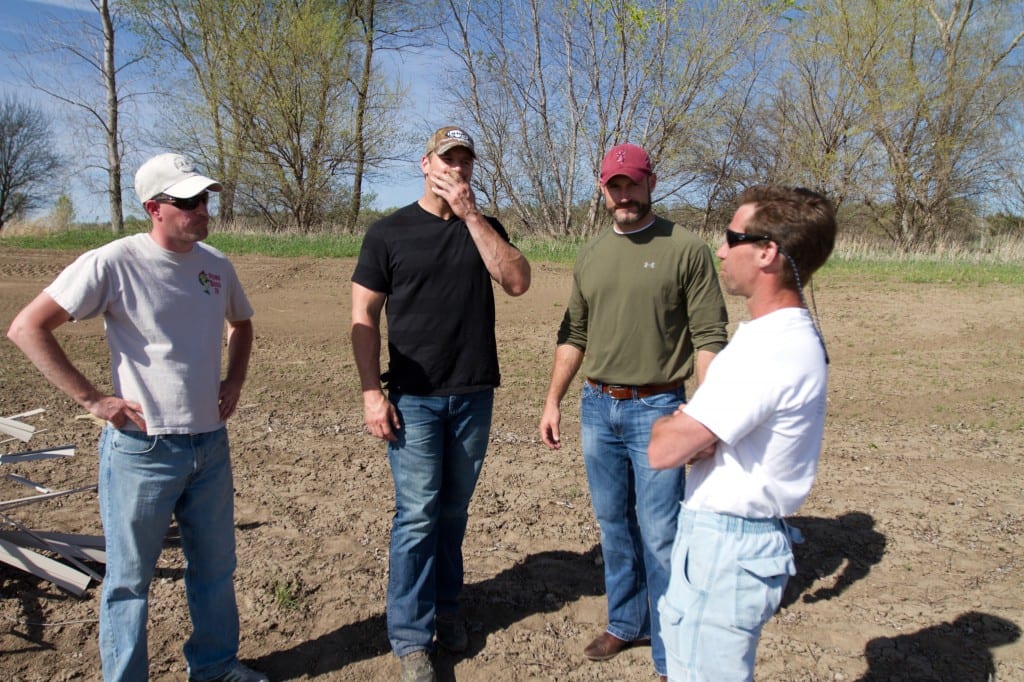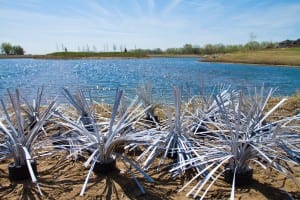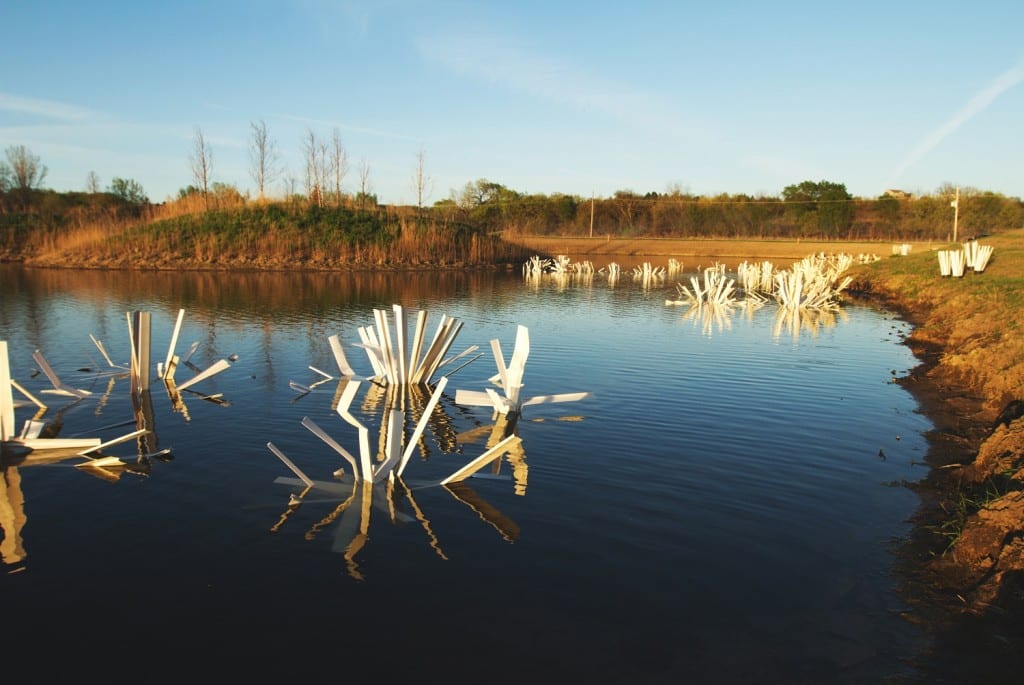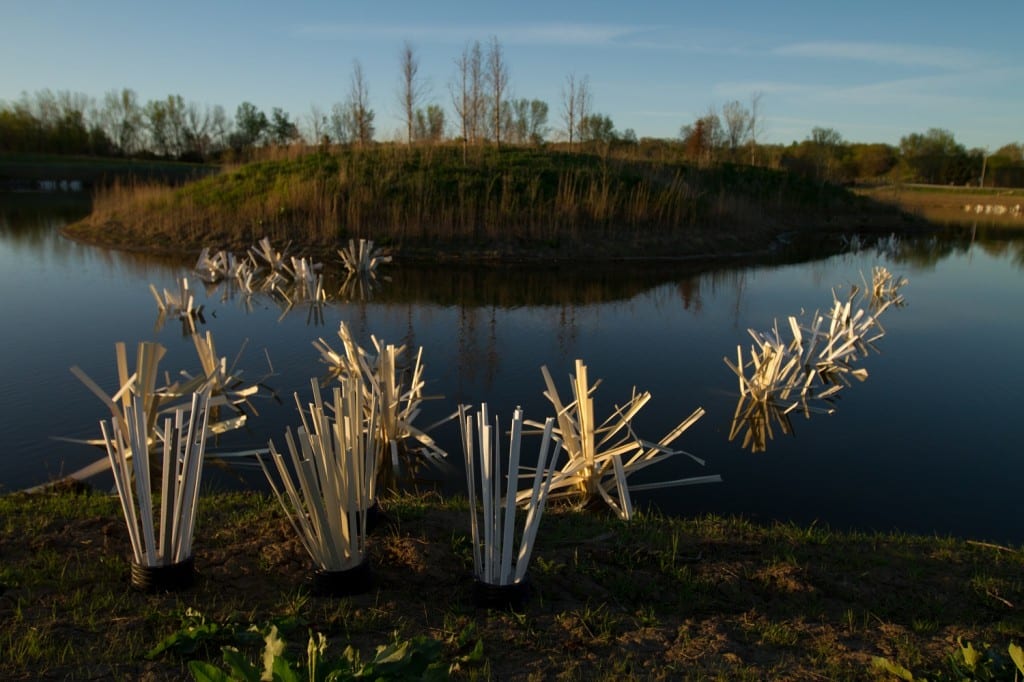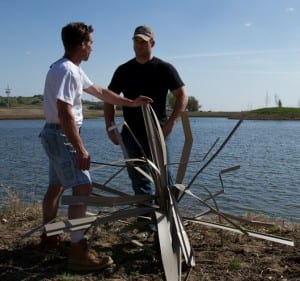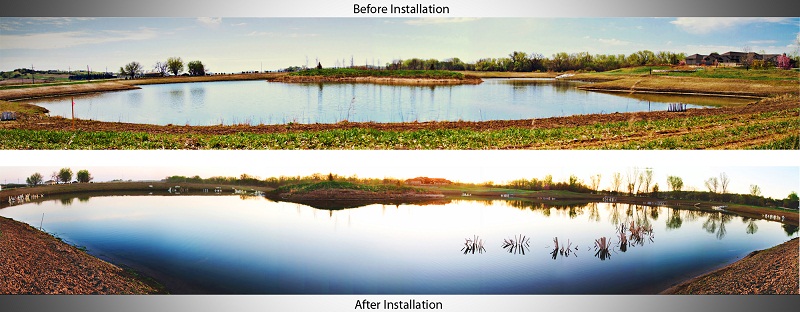Bringing Back the Fish: Michigan Sea Grant Oversees Successful Habitat Reconstruction |
| By Stephanie Ariganello, Michigan Sea Grant The unmanned camera bounced along a rock reef on floor of the St. Clair River. Researchers watched the monitor. Then a long, dark shape came into focus and another and another. The looming figures were lake sturgeon. The team whooped at the discovery: the restoration was working and much sooner than anticipated. The goals of the project are to:
“It is science in action,” said Jennifer Read, assistant director of Michigan Sea Grant and project lead on the St. Clair River Middle Channel Restoration project. “This is the kind of research project where we’re performing research not just to learn new things, but to apply what we’ve discovered. And with this project, we’ve been rewarded with early success.” The lake sturgeon were congregating on rock reefs installed as part of the restoration project in the St. Clair River, led by Michigan Sea Grant. The project focuses on restoring fish spawning habitat in order to add young fish to the stocks of several endangered or threatened fish species in Michigan, including lake sturgeon, mooneye, northern madtom catfish and river redhorse suckers. Valuable commercial and sport fish such as walleye, lake whitefish and perch are also expected to use the reefs for spawning. “Obviously there was a need for more spawning habitat based on the immediate response by the sturgeon,” said Terry Heatlie, habitat restoration specialist with NOAA Fisheries Restoration Center, Great Lakes Regional office. “It’s special because this would not have happened without the restoration project, without restoring spawning habitat in the river.” click to expand image  Reef habitat restoration in the St. Clair River Middle Channel. Credit: Michigan Sea Grant Reef habitat restoration in the St. Clair River Middle Channel. Credit: Michigan Sea GrantWhen given enough time, Heatlie said, some land or water issues heal themselves. With habitat restoration, that is not typically the case. It requires intervention. The construction was completed in June. Nine rock reefs were created, providing an acre of restored fish spawning habitat in the river. The St. Clair River connects the waters of Lake Huron to Lake St. Clair, where water then flows through the Detroit River and eventually into Lake Erie. The channel is a major shipping route and forms a border between the U.S. and Canada. Because of its location in the heart of the Great Lakes, the restoration has potential to benefit waters upstream and downstream of the construction. The restoration efforts could also provide cultural and economic benefits, bolstering commercial and sport fishing and contributing to a higher quality of life in an area currently listed as an Area of Concern under the U.S.-Canada Great Lakes Water Quality Agreement. See the dozens of unique artificial fish habitat models, fish attractors and fish cover at fishiding.com, the leader in proven science based, fish protection. In the early 1900s, the rivers connecting Lakes Huron and Erie were widened and deepened to accommodate larger, modern commercial shipping vessels. Dredging and depositing the materials in different locations in the river damaged fish spawning sites — and subsequently, fish populations. click to expand image  Researchers inspect egg mats as part of the Middle Channel Restoration project. Credit: Michigan Sea Grant Researchers inspect egg mats as part of the Middle Channel Restoration project. Credit: Michigan Sea GrantTo compensate for the habitat loss, Michigan Sea Grant and project partners (U.S. Geological Survey, Michigan Department of Natural Resources, U.S. Fish & Wildlife Service, the University of Michigan, NOAA, SmithGroup JJR andMichigan Wildlife Conservancy) constructed two reef projects previously in the Detroit River. The location and design of the Middle Channel reefs were chosen based on studies of fish populations and lessons learned during the previous projects. “That’s what is really unique about the Middle Channel project,” said Read. “It reflects over ten years of work performed by a multi-agency science team tackling increasingly complex questions over a large geographical area. It represents a successful, system-wide approach to restoration.” Researchers surveyed the new reefs and collected eggs. It was confirmed. Lake sturgeon successfully deposited and fertilized their eggs on the reefs and the eggs produced viable sturgeon larvae. Post-construction assessments are planned to ensure the Middle Channel Reefs are being used by a variety of fish species. The goal, aside from reestablishing the habitat, is to help remove the St. Clair River from the bi-national list of Areas of Concern. Two more spawning reefs for native fish are being planned for the St. Clair River in 2013 and 2014, as part of the Great Lakes Restoration Initiative. |
Tag: fish structure
MBL Recycling provides vinyl siding for fish habitat…by the tons!
Started in October 2002 with just one truck and 30 boxes, Wendy Gold and her brother Robert Lenzini have modeled the foundations of their family’s generational business, Lenzini Excavating, initiating 37 years ago, into today’s MBL Recycling, established as an operation that specializes in the recycling of construction waste and demolition debris. Slowly but surely, the company has modestly added to its fleet, which now counts to eight trucks and close to 400 boxes.
Over time, the company has grown from its initial days of hand sorting to separate the waste material to a state-of-the-art facility that brings efficiency to the sorting process and new levels to both volume and productivity. The facility current stands at 41,000 square feet.
Based in Palatine, Ill., where the company’s new facility was developed in 2005, MBL Recycling offers full roll-off container services to its customer base, offering anywhere from 10 to 30 yard containers. The recycled material sorted, processed, source separated and is then sold back to the market. For example, recycled shingles are turned to asphalt in order to construct city roads. In 2007, MBL Recycling added concrete washout containers to its extensive line of services, further improving its position in the marketplace, tackling the market with a different style box, while the boxes also better comply with growing environmental standards.
Programs and services
The addition of 11,000 square feet to its new material recovery facility allows plenty of space for future growth.
And as its volume has continued to grow, MBL Recycling has seen an increase in incoming streams from diversifying construction projects, further adding to both the demand and specification of the waste separation. Because of such a high volume with its customers, MBL Recycling was able to hold its percentage in the market as the company successfully navigated the impact of the global economic downturn, which was specifically damaging to the American housing economy.
Business development
“Construction is really down here. Housing has come to a halt. We were pretty fortunate though because we never really focused much on housing,” said Robert. “We did a lot more commercial and it has slowed down…but nowhere near the housing.
“Will next year be any better? It is still too early to tell. We see it from an excavating side because we can tell when they bring in bids and how much work is there for the spring, and there isn’t much,” added Robert, illustrating that the excavating business allows for a unique secondary insight into the future.
“We pinch ourselves everyday that we are here and still going. We are riding the storm and doing everything status quo until everything bounces back. We’re always thinking of new things, but we have a couple hurdles here in Illinois that we are trying to work on now too (like getting into the drywall recycling market),” said Wendy.
“We were able to pick up some of the slack from some of the other guys that were in the housing market. The shingles this year also brought our tonnages way up,” said Robert. “Before we used to have to ship [the shingles] to Wisconsin and they used them in asphalt mix. Just in the last year, Illinois recognized this and got a standard for it.”
“We do a lot of work with Power Construction (based in Schaumburg, Ill.), a high profile contractor. We do a lot of hospital additions. We just finished the Northwest Community Hospital nearby and that was a huge project. Astellas Pharma is another Power Construction job. It’s a three-year project that just started this year,” said Wendy.
But right now our only out is that we recycle our own stuff, so that is our little niche.” Associated with the U.S. Green Building Council, MBL Recycling provides all LEED documentation for its customers, generating environmental sustainability reports on a monthly basis.
The transition to ‘go green’ is something that is becoming a “really big thing with the general contractors…they love to recycle, especially with some of the locations around us,” said Wendy. “Hooray for Chicago because they mandate 50 per cent recycling of construction. It is wonderful that they recognize that.”
As such, in 2009, the Illinois Recycling Association recognized MBL Recycling as the Recycler of the Year.
Quality customer service
MBL Recycling prides itself on providing the best possible service to its customer base.
“Service is a big thing nowadays. People call and they want their stuff. It is not all about the pricing because at least when people call us they know we are going to be there,” said Robert.
“People are so thankful. You would be surprised at the phone calls—people go out of the way to call here and say something nice about one of our drivers, or for us being there in a pinch. Everyone gets the feedback and gets to feel good about things,” said Wendy. “We treat all of our customers the same—like gold.”
WWW.MBLRECYCLING.COM
http://www.youtube.com/watch?v=rv3M4zUsU5U&feature=player_embedded
 MBL is committed to environmental best practices and sustainability. MBL diverts millions of pounds that would normally go to landfill in your C&D container. MBL is taking C&D recycling to the next level. Diverting waste from landfills, promoting reuse and recycling in our community.What is your Current C&D waste management plan?
MBL is committed to environmental best practices and sustainability. MBL diverts millions of pounds that would normally go to landfill in your C&D container. MBL is taking C&D recycling to the next level. Diverting waste from landfills, promoting reuse and recycling in our community.What is your Current C&D waste management plan?Are your crews taking the time to separate each and every item and put them in separate containers for disposal?
 Do you have multiple containers to handle the variety of materials to be disposed?
Do you have multiple containers to handle the variety of materials to be disposed?Or are you already putting jobsite C&D debris mixed into one container?
MBL Recycling is ready to handle your C&D waste. Mix all C&D waste into one container. Do not incur the extra time and cost of separating materials yourself. No need for extra job crew training: just explain you will be recycling.
 Just direct ALL your C&D materials to MBL!
Just direct ALL your C&D materials to MBL!
MBL will take your C&D container and separate the recyclable materials for you. On average 75% of every C&D container is recycled. Allow us to recycle your construction and demolition debris, diverting tons of material from landfills.
 An alliance of professional environmentalists working to promote greener solutions. Find us atwww.thegreenteamchicago.com.
An alliance of professional environmentalists working to promote greener solutions. Find us atwww.thegreenteamchicago.com.
NFL Player Chris Kelsay Tackles Fishing Lake Project in Nebraska
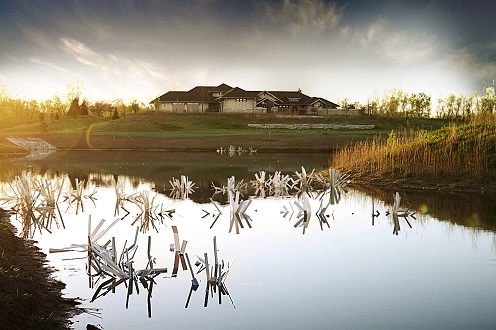
What kind of habitat helps the fish grow large and the water stay clear? Can you actually dictate where to cast your lure to find a bass lurking in the shaded cover like a defensemen reads a quarterback?
If you spend the time and effort to plan the design of your lake or pond from start to finish, you can achieve these goals and much more. Chris Kelsay, veteran linebacker/defensive end of the Buffalo Bills has a passion for more than just football. Chris not only loves to tackle running backs and wide receivers, but big bass are also on the hit list. Growing up in Nebraska, Chris has loved the outdoors all his life. When he’s not playing ball, he’s often talking fishing and hunting with his family and friends, planning his next adventure with his bow, firearms or fishing rods. Chris plays off the field with as much intensity as he does at work, stalking, sneaking and outsmarting his opponents with hard work and dedication.
Another NFL great that is no stranger to the outdoors is Aaron Graham, former Center for the Arizona Cardinals, Oakland Raiders and finishing up his career with the Tennessee Titans. These two guys have quite a bit more in common than playing ball in the NFL. Not only are they neighbors near Gretna Nebraska, but they both love to fish and hunt, having their own private lakes that they enjoy with their families and friends. Both these guys played college ball for the Nebraska Cornhuskers, as well as Chris’ brother Chad. Retiring from the NFL, Aaron now owns and operates his own company called “Premier Outdoor properties”, which specializes in large tract farm, ranch and recreational real estate throughout Nebraska, Kansas, Iowa and Missouri. Participating with Cabela’s Trophy Properties, his firm can help you find your dream hunting and fishing, farm and ranch, lake or river frontage, and large tract acreages, to meet any needs you may have.
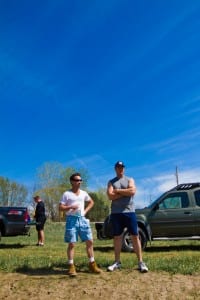
Aaron has had his lake stocked with an exceptional strain of bass, with catches to date over eight pounds by his son Cooper. With the lake being about seven years old, Aaron has a jump start on Chris with some experience in habitat, stocking and water quality. We met Aaron over a year ago, providing him with some of our artificial fish habitat products for his lake. Follow this link to read about aaron’s habitat project. The success he has had with our products, encouraged him to put Chris in touch with the team at Fishiding.com to discuss a plan for his first of two lakes, as it was getting ready to be filled to full pool. With a large well, levelor system, aeration and a stocking plan in place, we came up with a plan and design to meet Chris’ desire to create a personal, one of a kind fishery. The first lake Chris has on his property, at just over six acres, needs plenty of cover for the fish to spawn, hide and hunt within. A well known and respected fisheries biologist Bob Lusk of Pondboss.com, recommends at least 20% of the surface area of a lake or pond be provided in habitat.
See the dozens of unique artificial fish habitat models, fish attractors and fish cover used at fishiding.com, the leader in proven science based, fish protection.
With plans to include aquatic plants, wood and rock, we came up with an array of artificial habitat models to make up about 25% of the needed habitat for Chris’ first lake. We have always felt that a variety of natural and artificial habitat provides the diversity, all types of fish species need to utilize throughout the year. Like most things in life, everything in moderation seems to achieve the maximum efficiency and ultimate benefits for a fishery.
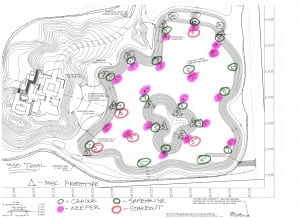
The plan we came up with provided an array of structure textures, sizes and shapes to best provide cover for fish spawning and growing habitats. A total of 350 individual habitat units were hand selected to best achieve Chris’ goals to create a trophy bass fishery. A key element to any habitat plan is to create a line of structure from shallow water spawning areas out to mid depth and ultimately deep water cover. This allows young fry to hide in fine, dense cover immediately after hatching, in the shallow water they are spawned in. As these young of the year fry develop and explore out to mid depth ranges, they need to have cover to utilize as they progress deeper. If this cover is not available, they get eaten before reaching preferred size by predator fish. It is imperative that these small fish are able to hide and grow larger to the 3″-5″ size before becoming forage for the game fish. A bass for instance, needs to eat 10 pounds of forage to put on just one pound in weight. If that bass eats the fry before they get large enough, he will eat them all up just to satisfy his hunger and desire to put on weight.
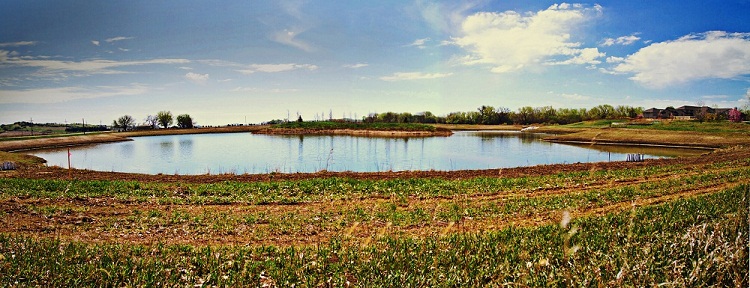
We put our plan together to deliver the structure and help Chris with the installation. Although artificial habitat only needs to be installed once, this was a large amount of structure to ship and install at one time. It was decided we would drive the almost 7200 pounds of habitat out in our own truck and trailer from our facility in northern Illinois. The 475 mile trip had us arriving by lunchtime on a Friday, with the hopes of finishing the installation late Saturday evening, for the return trip on Sunday.
Three of us set out at 4:00 a.m. Friday to achieve our goal. Our son Graham, an electronic media/photography major at Moody Bible Institute in Chicago, came to capture the project in high definition pictures and video and help with the installation process. Also along was our nephew Josh Fick, a starting player for the North Central college football team, over excited to meet and work with the NFL players. Meeting us there was Josh Milczski, a Nebraska native, writer for recycled fish.org, a pond boss moderator and Nebraska Fish and Game board member to lend a hand and share his knowledge. Also on hand to help was Chris and Chad Kelsay, as well as Aaron and Cooper Graham.
We unloaded all 350 units and spotted them around the lake per plan Friday afternoon and then when out for a well desreved Nebraska steak dinner to re-fuel for the big push on Saturday.
The weather was un-seasonably hot, with temps. in the low 90’s and full sun. None of us expected to be getting sun burn in march, let alone starting to find Morel mushrooms already. The turkey were gobbling on the roost as we set up for a long day of work, unfolding each unit and stocking them on the bank near their final resting place. Geese and ducks of all varieties, came in and out of the lake all day, giving us a show of the abundant wildlife in the area. There was about 2 feet of water existing in the lake from runoff and ground water level, an ideal situation to put our plan into motion.
Three Nebraska Boys and one flatlander plan the attack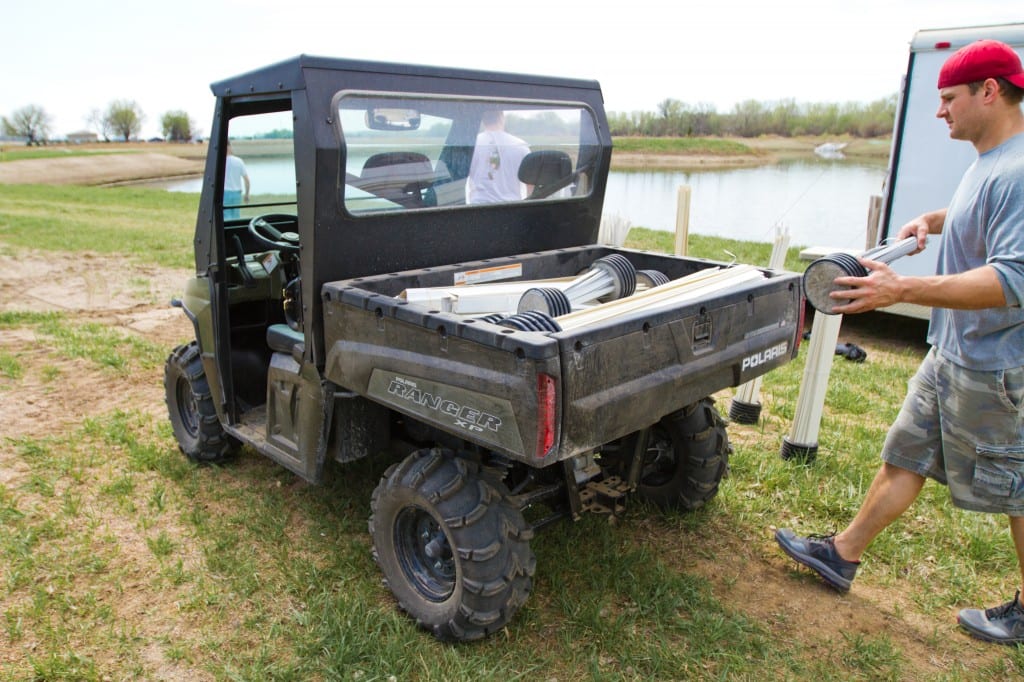
The “Kelsay express” saved lots of time
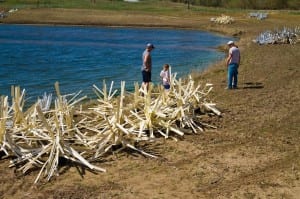
The Fishiding fish habitat products are all made from reclaimed PVC vinyl siding that was destined to be put in landfills. Over 50% of the material acquired has never been used on buildings and will last for many generations to come. This safe, inert substrate, works perfectly for underwater applications in fish habitat. Our main supplier of discarded siding comes from K. Hoving companies. This state of the art waste removal operation currently recycles an astounding 75% of the trash they collect. Re-use is the term they use to explain their company goals. See this story about their firm and the great things they are doing to help our environment. Add the cover and your fish will prosper, Go-Green and save the environment all at the same time.
All fishiding units come complete, ready to sink with no assembly or additional parts/tools needed. Simply open the box, bend to any desired shape and toss in the lake. Each unit sinks upright with the included “stump like” base. There is no incorrect or wrong shape, as diverse as Mother Nature. Artificial habitat products are being used all around the country, as biologists learn more about the many advantages they offer. Years of use from these structures allow anglers and pond/lake owners a snag free habitat for fish to utilize. Saving the environment, these fish attractors help conserve energy with no manufacturing process involved.
Cleaned, cut into various shapes, widths and sizes then cemented into just about any type of safe container, fishing groups are getting involved in creating new habitats lost from degradation and development. All of the fishiding models are available shipped loose as well as in a completed form. Customers can save money by purchasing loose pieces of the PVC in all varities and create their own custom designs by using their own container and cement. A special mixture of cement is also available to ensure a tight, fool proof bond to the vinyl. The pieces and models come in an array of colors, just like the colors available when siding your new home. After the algae and bio film begins to grow, they all take on a greenish/brown appearance.
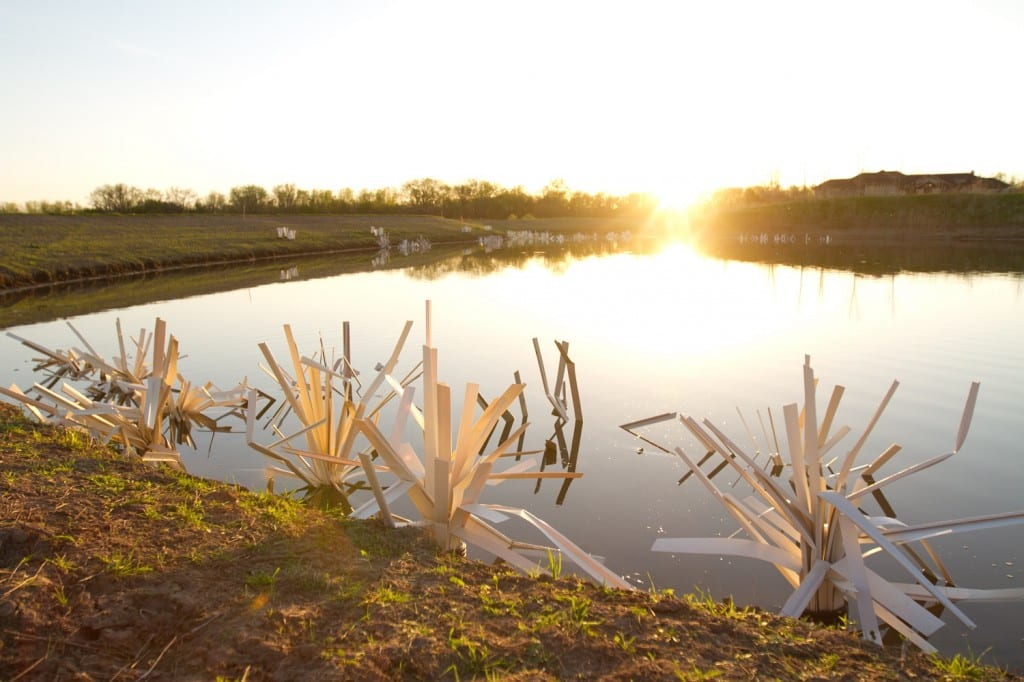
Groups like the B.A.S.S. Federation Nation have begun to incorporate Fishiding habitat products into their ongoing conservation efforts. Projects in West Virginia were recently completed with great success. Plans to work in New Mexico, South Dakota,Virginia and Texas are being put together currently with the conservation directors in those states. The B.A.S.S. Federation Nation leads the industry by example in conservation work with groups in all states and Canada promoting conservation and water quality issues world wide.
Lake and pond owners enjoy the ease of installation, with no need to ever replace. The limbs all have any holes or notches removed to make each unit snag resistant,unlike brush and Christmas trees. By providing shallow habitat for fry and forage fish, mosquitos can be almost eliminated in the area, as they feed on these pesty critters. Shallow habitat is the key to growing your own forage base, thus eliminating the need to constantly restock minnows to feed your game fish.
100 Keeper models were incorporated into the plan for deep water structure. These large units each boast over 62 square feet of surface area and allow predator fish to hunt and hide around. When opened and bent to shape, they cover a seven foot diameter and are best installed with about a foot of space in between. This allows fish to navigate through them, feeding and resting in the shade they produce. Bass prefer the dense cover and shade that these fish attractors provide.
Also part of the plan was to install 25 Stakeout structures, which are artificial stake beds, crappie and bluegill fisherman use a great deal in the south. These units stand 48″ tall and have an open grouping of individual “sticks” that the panfish prefer. Another 50 smaller prototype versions of these were installed in shallow areas for young of the year fish to navigate through as well.
See the dozens of unique artificial fish habitat models, fish attractors and fish cover used at fishiding.com, the leader in proven science based, fish protection.
With all the help and planning, we were able to meet our goal and finish installing all 350 Fishiding habitat units by sundown on Saturday. Chris welcomed us into his beautiful home and surrounding landscape. Although we had no time to hunt or fish while we were there, plans are being made to come back to install our habitat products in his second, five acre lake. With common goals of preserving our natural surroundings and creating a fantastic fishery, we are planning to spend some time together in the great outdoors with bows, guns and fishing rods in hand. New friendships have been made, stories of the hunt continue to be shared and the love of the great outdoors continue to be the catalyst for a common bond between men from all walks of life.
Fish Habitat Key Part of B.A.S.S.Summit
B.A.S.S. News Announcement: Conservation Summit Deemed ‘Huge Success’
 Awesome. Tremendous. Terrific. That’s the way that state conservation directors (CD) for the B.A.S.S. Federation Nation summed up their experience at the recent Conservation Summit in Shreveport, La.
Awesome. Tremendous. Terrific. That’s the way that state conservation directors (CD) for the B.A.S.S. Federation Nation summed up their experience at the recent Conservation Summit in Shreveport, La.
Staged during Bassmaster Classic Week, the event featured 2 ½ days of presentations and discussions on issues of concern to bass anglers nationwide. Fisheries experts from universities also attended, as did fish chiefs and biologists from state and federal agencies.
“The Conservation Summit was terrific,” said Scott Sowell, veteran CD from Maryland. “Noreen (National Conservation Director Noreen Clough) did a fantastic job putting it together, and I left fired up to spread the word on keeping bass alive!
“It was great interacting with CDs and fisheries biologists from all over the country. I learned quite a bit about conservation issues and practices in other states and steps they take to protect the fishery.”
Clough called the Summit “a huge success,” but wanted no credit for it being so. “I was impressed with the number of states who recognized the value of this and attended,” she said.
“And it was capped off by a variety of academics like Dave Philipp from the University of Illinois, Mike Allen from the University of Florida and Jeff Koppelman from the Missouri Department of Conservation. They stimulated thought and conversations.”
Those three joined Gene Gilliland from the Oklahoma Department of Wildlife Conservation and others as presenters on Day 2 of the event, billed as a Fisheries Management Workshop.
“We talked about the state of the science on black bass issues,” Gilliland said. “We made presentations on some of the more controversial issues, such as fishing for spawning bass, to give the CDs a feel for what is going on, and then we had question-and-answer time.”
Based on the presentations and follow-up breakout sessions, attendees then identified major management issues for black bass fisheries. They include the following:
- Fish care during tournaments, with pro anglers serving as role models.
- Introduction of native and non-native species, including anglers who illegally move fish.
- Large-scale habitat projects, with federal involvement.
- Current and future water wars, and the need for anglers to partner with U.S. Forest Service, the U.S. Fish and Wildlife Service (FWS) and the states to ensure allocations for fisheries.
- Fostering better relationships with fisheries agencies.
The Summit also included national and state legislative updates from Gordon Robertson of the American Sportfishing Association and Chris Horton, Mid-States Coordinator for the National Assembly of Sportsmen Caucuses. The two also led a discussion on working with legislators.
“You have to engage politically because management of our natural resources often is political instead of biological,” Horton said.
On the Summit’s final day, Gilliland explained the process behind fisheries management, and fish chiefs provided the “state perspective” on building partnerships.
See the dozens of unique artificial fish habitat models, fish attractors and fish cover used at fishiding.com, the leader in proven science based, fish protection.
Additionally, representatives from the FWS talked about that agency’s programs and the 75th anniversary of the Sportfish Restoration Program (also known as Wallop-Breaux), which provides millions of dollars annually for state fisheries management through excise taxes on fishing gear.
2012 Bassmaster Classic Official Sponsors: Toyota, Bass Pro Shops, Berkley, Evan Williams Bourbon, Humminbird, Mercury, Minn Kota, Nitro Boats, Skeeter Boats, Triton Boats, Yamaha
2012 Bassmaster Classic Supporting Sponsor: Carhartt
About B.A.S.S.
For more than 40 years, B.A.S.S. has served as the authority on bass fishing. The organization advances the sport through advocacy, outreach and an expansive tournament structure while connecting directly with the passionate community of bass anglers through its Bassmaster media vehicles.
The Bassmaster brand and its multimedia platforms are guided by a mission to serve all fishing fans. Through its industry-leading publications — Bassmaster Magazine and B.A.S.S. Times — comprehensive website Bassmaster.com and ESPN2 and Outdoor Channel television programming, Bassmaster provides rich, leading-edge content true to the lifestyle.
The Bassmaster Tournament Trail includes the Bassmaster Elite Series, Bass Pro Shops Bassmaster Open Series, Carhartt Bassmaster College Series, Cabela’s B.A.S.S. Federation Nation events and the ultimate celebration of competitive fishing, the Bassmaster Classic.
B.A.S.S. offers an array of services to its more than 500,000 members and remains focused on issues related to conservation and water access. The organization is headquartered in Birmingham, Ala.By Staff Writer
Growing plants and installing artificial fish habitat to grow more fish in reservoirs
UNDERWATER RE-EVOLUTION
By Larry D. Hodge
A revolution is brewing among biologists managing freshwater fisheries in reservoirs. Or, put another way, a
re-evolution of fisheries management is taking root.
See the dozens of unique artificial fish habitat models, fish attractors and fish cover used at fishiding.com, the leader in science based, proven, fish protection.
Rather than applying a top-down approach to fisheries management by stocking fish, biologists are going bottom-up by stocking plants and putting in fish attractors to create habitat, sort of an “if we build it, they will come” approach. The movement to improve fish habitat in reservoirs falls on particularly fertile ground in Texas, where hundreds of constructed reservoirs dominate the landscape in a state that has only one natural lake of significant size but more inland water than any other state (except Alaska).
Dave Terre, chief of research and management for the Texas Parks and Wildlife Department’s Inland Fisheries Division, is a leader in the nationwide movement to improve fish habitat in reservoirs.
“About four years ago people from state wildlife agencies across the United States had the idea of creating a habitat partnership focused on reservoirs,” he explains. “That movement became the Reservoir Fisheries Habitat Partnership (RFHP). The goal is to improve fish habitat in reservoir systems, including the river above and the tailrace below, recognizing that you can’t always just do something in the reservoir and expect a positive change.”
Reservoirs are unnatural systems, often lacking in native aquatic plants. Damming a stream and flooding the terrestrial habitat around it creates a bizarre submerged waterscape of dead trees, brush, old roadbeds and whatever else was built on the land. Decaying vegetation releases nutrients into the water that jump-start the fishery and maintain it for a time, but reservoir fisheries typically decline over time as the flooded vegetation degrades. Stocking fish into this alien world creates a fishery, but one not likely to be sustainable or able to reach its full potential.
The importance of plants in reservoirs is difficult to overstate.
“The function of plants is to capture sunlight and turn it into food,” says Richard Ott, a fisheries biologist for the Texas Parks and Wildlife Department. “Everything starts with aquatic plants. Some are food for fish directly, but more importantly, they are also food for insects and invertebrates that are eaten by small fish that are eaten by big fish and then by us. Plants provide cover for small fish to hide in and grow. They generate oxygen, buffer changes in pH, slow wave action and filter water.”
Plants do much more for reservoirs, their watersheds and the people who live there than just provide for the needs of fish.
“Tying down the shoreline and reservoir bottom with native vegetation reduces erosion and the amount of suspended sediment in the water,” TPWD fisheries biologist Mark Webb points out. “Because plants are taking nutrients out of the water, algal growth is reduced, which helps improve the quality of drinking water. Once well-established, native plants give a great amount of benefit for low cost.”
Native plants also help fight invasive nonnative species such as hydrilla.
“We try to fill a niche,” says Ott. “If you have a bare piece of ground and want to keep it that way, you have to be doing something all the time to kill stuff trying to fill that open niche. If we can fill that niche with native species, it makes it harder for exotic species to get established. Waterfront property owners may object to having any plants, but they should understand that plants outside a bulkhead area dissipate wave energy, which means they don’t have to replace expensive bulkheads as often. Once they see native plants as being a lesser evil than exotic species, they get on our side.”
Partnerships are key to the effort.
“Funding these projects is a huge problem for many states,” Terre observes. “The only way we can do that is through partners. We created a 501(c)3 corporation, Friends of Reservoirs, to be the financial arm of the RFHP. We are reaching out to organizations such as bass clubs, watershed groups, homeowners associations, individuals — anybody who is interested in improving fish habitat to benefit water quality, fish and the quality of life of the American people.”
Ott and Webb have been in the forefront of efforts to introduce native aquatic plants into Texas reservoirs, following the lead of the U.S. Army Corps of Engineers’ Michael Smart, head of the Lewisville Aquatic Ecosystem Research Facility.
“When Dr. Smart suggested that we should stock native aquatic plants for the same reasons we stock fish, we wanted to kick ourselves for not having seen the obvious,” Ott smiles. “You have to ask yourself when you stock fish: Where will they live and what will they eat?
“There are aquatic plants native to Texas that will survive in reservoirs,” he continues. “These plants lived in wetland areas and backwaters of streams. But you can’t plant them just anywhere. In reservoirs you have to deal with fluctuations in water levels. Plants have to be matched to the water depth and clarity they need. They have to get sufficient sunlight to grow, but they can’t be planted so shallow they will be dry at the times they need to be growing.”
Using plants from Smart’s Lewisville facility, Webb and Ott experimented on seven Texas reservoirs that represent a cross-section of conditions across the state to develop a list of native Texas plants that will survive under a variety of conditions. They also experimented with techniques to aid survival of these plants under reservoir conditions different from those of natural lakes.
Like Smart, they decided that a founder-colony approach works best. Plants are raised in a nursery in plastic pots before being transplanted to a reservoir, where they are enclosed in a wire cage to prevent being eaten by turtles, fish or land-based herbivores. Over time the plants spread outside the cages.
After this first phase, biologist made plantings in Lake Bellwood, a former water-supply lake for the city of Tyler, to demonstrate what they had learned.
Stocking plants in reservoirs throughout Texas presents a tremendous challenge. The first hurdle to overcome is establishing a reliable and affordable supply of plants. Nursery facilities have been set up at the Texas Freshwater Fisheries Center in Athens, at the Lake Waco wetlands and on San Jacinto River Authority (SJRA) property at Lake Conroe. The latter furnishes the model for how the Friends of Reservoirs process is envisioned to work.
“The Seven Coves Bass Club on Lake Conroe has been one of our major partners,” Webb says. “Seven Coves members approached me to ask about stocking fish, and I steered them toward native vegetation. It was not a tough sell. They are really conservation-minded. I explained that the lake has good water quality, good nutrients and good spawning areas, but it did not have good habitat for small fish to hide in. Club members saw we had a huge increase in our bass production after we planted some shoreline vegetation, and they really got excited.”
Former Seven Coves President Ron Gunter recalls: “We got a grant through the U.S. Fish and Wildlife Foundation that let us create a native aquatic plant nursery at the SJRA Lake Conroe property. The SJRA donated the land. We purchased the construction materials and built raceways for the nursery and got plants from the Lewisville Aquatic Ecosystem Research Facility. We put half the first shipment of plants in the lake and kept the second half for seed stock.”
Involvement with the project brought public exposure that helped increase Seven Coves membership from 17 people in 2005 to nearly 70 at present. Seven Coves Bass Club is now the first organization in the nation to be granted chapter membership in the Friends of Reservoirs.
“We intend to continue with the native plant restoration project in hopes we can sustain what we consider to be an excellent fishery in Lake Conroe,” Gunter says. “The payoff is knowing that we’ve done something that can make a change for future generations. We’re not looking for immediate dividends; we’re trying to make it possible for our children and grandchildren to enjoy Lake Conroe like we’ve been able to.”
Other projects carried out by the Seven Coves Bass Club include a grass carp removal tournament with the assistance of the Texas Bow Anglers Association, the installation of more than 700 cinder-block-and-bamboo fish attractors and the introduction of native plants along miles of shoreline.
The fish attractors and the plants are two sides of the same coin. “The spider blocks are the temporary habitat; the aquatic plants will be the permanent habitat,” Gunter says.
Funding projects through the Friends of Reservoirs allows local groups to raise money under the organization’s 501(c)3 umbrella, making it easier to attract corporate donors. All funds raised by a group are earmarked for the group’s projects and are not shared with anyone else, which helps maintain local control.
“The Friends of Reservoirs is a great deal in that regard,” says Gunter. “Check it out and then get out and beat the bushes for funds.”
It’s often said that “what happens in Vegas stays in Vegas,” but with water, what happens in a watershed ends up in a reservoir. Friends of Reservoirs projects will coordinate programs targeting land management practices in watersheds to improve the quality and quantity of runoff into reservoirs.
“Re-establishing native vegetation in Lake Conroe will have some beneficial effect from the standpoint of water quality,” says SJRA Lake Conroe division manager Blake Kellum, “but primarily what we recognize is benefit to the ecology of the reservoir. We view ourselves as stewards of the reservoir and want to take a balanced approach to the management of that resource. We are trying to put as much effort into native plant restoration as we did trying to control invasive species on the front side.”
It’s a team effort. “Scaling up for big projects will require more equipment and labor,” says Ott. “That’s where volunteer groups can really help out. If a group wants to take on a project, we have the expertise and the plants. If they can provide the people, it becomes fairly simple. Historically, that’s how we’ve manipulated fish populations, by regulations directing harvest to the size fish we need to have removed. All along, anglers have been the ones pulling the plow while we walk along behind directing where the plow should go.”
The Friends of Reservoirs program makes it possible for everyone interested in a lake to help pull the plow. Anglers, boaters, area property and business owners, water utilities and consumers and anyone involved in water-based industries will benefit from improved water quality, control of invasive aquatic species and reduced maintenance and operation costs from lower rates of erosion and sedimentation.
“There are already lots of groups out there working with their fisheries biologists planting native vegetation or placing brush piles,” Terre says. “All of those could be a Friends of Reservoirs chapter. This is not a governmental organization, but rather partners from across the United States who are interested in improving fish habitat. Reservoir partnerships are the way all those people will connect to work with each other. I really believe we can make a difference.”
Related stories
Demands on Lakes Rising; Now’s the Time to Address Water Needs
Newman Branch Creek Habitat Restoration Project
2011: CRP Project # 10-06 Newman Branch Creek Phase II Habitat Restoration
The Newman Branch Creek Habitat Restoration Project, located in southeast Hillsborough County, Florida, will be undertaken in an effort to restore estuarine and freshwater habitat in the Tampa Bay area. The project will involve the removal of invasive exotic species, primarily Brazilian pepper (Schinus terebinthifolius) and the re-creation of a variety of native estuarine, freshwater, and upland habitats. Historically Tampa Bay has lost up to 40% of its original marsh/mangrove habitat, with the oligohaline environs having the greatest proportion of these impacts. The Tampa Bay Estuary Program (TBEP) and the Southwest Florida Water Management District’s (SWFWMD) Surface Water Improvement and Management Program (SWIM) have both identified that these habitats are critical in the restoration of Tampa Bay. This
project will further those objectives by resulting in at least 6 acres of estuarine habitat restoration/creation for fisheries habitat, which addresses the priorities identified by the TBEP.
See the dozens of unique artificial fish habitat models, fish attractors and fish cover used at fishiding.com, the leader in science based, proven, fish protection.
Project Name
Newman Branch Creek Phase II – Habitat Restoration Project
Project Location
Hillsborough County, Florida
Latitude/Longitude of the project site
27.78137 -82.404148
Land Ownership
Private -Tampa Electric Company (TECO) with a perpetual Conservation Easement
Anticipated NOAA Trust Resource(s) to benefit from restoration
Snook (Centropomus undecimalis), redfish (Scicenops ocellatus), spotted sea trout (Cunoscion nebulosus), and perhaps the Atlantic Sturgeon (Acipenser oxyrhynchus)
Project Start Date: December 2010
Project End Date: December 2011
Contact Info
Thomas F. Ries, Board President
Ecosphere Restoration Institute, Inc.
5886 E. Fowler Ave.
Tampa, Fl. 33716
www.ecosphererestoration.org
Bluegill habitat moves to artificial products to attract more fish
Bluegill Habitat
When you go bluegill fishing habitat is one of the key factors on your mind when deciding where to go to find fish to catch. Some bodies of waters are habitat rich with aquatic plants, dead falls, stumps and so on. Other ponds either never had good structures for habitat or they rotted and decomposed long ago. One option is to sink more structures with items from around the house for little or no cost such as old Christmas trees, pallets or scrap wood formed into a 3D design. These structures are great for a while, but they eventually break down or change until they are no longer a desired location for bluegill to gather.
See the dozens of unique artificial fish habitat models, fish attractors and fish cover used at fishiding.com, the leader in science based, proven, fish protection.
Kansas Seniors expected to pay for fish habitat improvements
Outdoors: Older outdoorsmen may face fee
KDWPT wants to do away with ‘fish, hunt for free’
Since 1971, Kansas residents who are 65 years of age or older haven’t had to purchase a Kansas hunting or fishing license. The Kansas Department of Wildlife, Parks and Tourism (KDWPT) is asking the 2012 session of the Kansas Legislature to consider removing these license exemptions for people 65 years of age or older.
According to KDWPT officials there are several reasons for this request. The KDWPT operates its fisheries and wildlife programs without the aid of Kansas state general fund tax money. These programs are paid for by licenses and permit fees charged for various hunting and fishing activities. In addition, for each license sold in Kansas the state receives federal money as a match from excise taxes on hunting and fishing equipment.
This money is allotted to each state based on the number of licenses sold and divided accordingly. Fifteen percent of the KDWPT budget for fisheries and wildlife programs comes from the federal funding matching money.
Fishing and hunting programs in Kansas are supported by license and permit sales. According to the KDWPT, removing the senior exemptions will assist the agency to continue providing a variety of outdoor opportunities. One popular example includes the Kansas Walk-In Hunting Area program which has opened more than a million acres of private land for public access. Another is the Community Fisheries Assistance Program which has opened more than 200 community lakes for fishing.
Additionally, license money is used to pay for fisheries management and fish stockings in 24 federal reservoirs and 40 state fishing lakes. In addition, license fees aid wildlife-related law enforcement, wildlife management on 100 public wildlife areas, boating access, fish habitat programs, research, education and wildlife population and health monitoring.
The KDWPT recognizes the changing demographics of Kansas residents. More people in the Baby Boomer generation will be reaching their 65th birthdays in the coming years. For example, the number of deer hunters 65 years of age and older that purchased deer permits has increased 25 percent in the last five years. Concern is that without a broadened funding base when many of these users leave the system others still paying for annual licenses will have to carry a heavier burden for fish and wildlife programs. The KDWPT said the elimination of the senior license exemptions will spread the cost among those that use the resources, keeping them equal and affordable for all.
Individual hunting or fishing licenses cost $20.50 for the calendar year. A combination hunting/fishing license is $38.50 which amounts to 11 cents per day. The KDWPT points out that the cost of a yearly license is a bargain compared to other forms of entertainment like dining in a restaurant, watching a movie or playing a round of golf. In addition, they point to the cost of the license as but a small percentage of the overall cost of other expenses relating to a hunting or fishing experience.
The KDWPT estimates the lost revenue from the senior license exemptions are considerable. Calculations used based on the U.S. Fish and Wildlife Service’s (USFWS) 2006 National Survey of Hunting, Fishing and Wildlife-related Recreation in Kansas (survey results from the most recent USFWS survey will be available this summer) estimates that 20,000 Kansas residents 65 years of age and older hunted in Kansas that year.
The KDWPT receives $18 from each license (after vendor and convenience fees) which would amount to $360,000. Matching federal money for each hunting license is $16.15. Subtracting 7,696 (the number of seniors who purchased a deer or turkey permit which can be counted for federal aid matching funds) that amounts to $198,709 in federal matching money for hunting licenses for a total of $558,709.
Using similar formulas and information, the KDWPT estimates lost revenue from annual fishing license exemptions for seniors amounts to $847,289. This is based on 33,000 anglers 65 or older at $18 for a total of $594,000. Federal aid ($8.31 is available as a match for each fishing license) from the sales of these licenses would amount to $253,289 (subtracting 2,520 anglers who purchased third pole or trout permits which can be used for federal aid reimbursement).
The KDWPT says it doesn’t want to unfairly target seniors who enjoy hunting and fishing. However, more than $1.4 million in lost revenue is substantial. They believe the elimination of the exemptions will make the license fee structure more equitable for all hunters and anglers and help to continue programs and services they enjoy.
Individuals wishing to express their concerns or questions are encouraged to contact their elected officials, or they can contact the KDWPT Office of the Secretary, 1020 S. Kansas Ave., Ste. 200, Topeka, KS 66612, or call (785) 296-2281.
HEARING SET FOR WATERCRAFT TAX
House Concurrent Resolution 5017 will have a hearing at 10:30 a.m. on Feb. 2 in Room 152 S in the State Capital. This addresses the current rate of taxation on watercraft in Kansas.
Currently, watercraft are taxed at 30 percent of assessed value which is considerably higher than cars, trucks, recreational vehicles and motor homes. The House of Representatives passed HCR 5017 in 2011 by a vote of 121 yea, 2 nay. It now must be approved by the Senate before it can be voted on by the public as a change in the Constitution.
The Kansas Department of Wildlife, Parks and Tourism (KDWPT) estimates as many as 10,000 boats and other watercraft are registered in other states to avoid paying Kansas property taxes. As a result, counties lose considerable revenue and the KDWPT loses revenue as well as federal aid reimbursable matching monies for improvements in boat ramps, safety markers and buoys, boating access, boater education and enforcement. The KDWPT supports this resolution.
If passed by the Senate, the resolution will go on the ballot to be voted on by the public as a change to the Constitution in the November 2012 election. If approved by the public, the 2013 session of the Kansas Legislature will determine how much to lower the current rate of taxation on watercraft personal property. This process already has been completed for vehicles, camping trailers and other recreational vehicles.
Anyone wishing to participate in the hearing and provide comments can contact Mary Jane Brueck, Committee Assistant at (785) 296-2713.
See the dozens of unique artificial fish habitat models, fish attractors and fish cover used at fishiding.com, the leader in science based, proven, fish protection.
Marc Murrell can be reached
at mmoutdoors@cox.net.
Conservation effort sets priorities for habitat
By DOUG WARNOCK
For the Capital Press
Forest resources, arid lands habitat and Puget Sound health were the areas selected as priorities for the Washington State Coordinated Resource Management program.
Washington’s CRM Executive Committee and CRM Task Group met together to establish program priorities. Reduced funding and loss of a full-time program coordinator precipitated the need to streamline activities and focus on high-priority needs.
The three areas deemed of greatest need were:
* Forest resources, emphasizing water issues.
* Arid lands habitat, focusing on sage grouse and endangered fish.
* Puget Sound health, emphasizing improved water quality.
The CRM Task Group is implementing a plan to assist new groups organized to address issues in the three priority areas, while continuing to support existing CRM groups across the state. The Task Group is led by Kevin Guinn, Natural Resources Conservation Service range management specialist, and facilitated by Ray Ledgerwood, Washington Conservation Commission Program Facilitator.
Coordinated resource management is a collaborative approach to resolving issues and improving management of land and water resources. The approach has been in existence in Washington state for over 50 years and has resulted in improved health of soil and water resources across the state.
A group in the Tenmile Watershed of Whatcom County stabilized stream banks and improved fish habitat. It involved local dairies, poultry producers, fruit and vegetable farmers and many community members.
A program in Klickitat County resulted in the development of 30 springs as water sources for wildlife and livestock, installation of 50 miles of fence to protect riparian areas and trees planted on 100,000 acres for forest renewal.
These are just two examples of successful programs. See the dozens of unique artificial fish habitat models, fish attractors and fish cover used at fishiding.com, the leader in science based, proven, fish protection.
Planning for any program is done by the local people who are responsible for managing the land and who have the best knowledge of the situation. Resources of the State CRM Executive Committee and the state CRM Task Group are available to support local groups as needed.
The program planning process empowers local people to solve land use and natural resource issues through collaboration. It brings people together, enhancing communications and reducing conflicts, to help find common ground while working toward the achievement of mutual goals.
Consensus is the basis for success in planning. The approach works because planning together across ownership lines and management boundaries results in better resource health, helps people meet their objectives and minimizes conflict among participants. While there may be a difference in how individuals view a problem or situation, all have an interest in the land’s well-being and can find mutual objectives for its benefit.
The CRM Executive Committee is composed of the heads of the state and federal agencies associated with land and water resources. The CRM Task Group includes representatives of the same state and federal agencies involved in the Executive Committee, as well as several members at large. All are dedicated to enhancing the health and well-being of natural resources in the state.
Doug Warnock, retired from Washington State University Extension, now lives on a ranch in the Touchet River Valley where he consults and writes on ranch management.
Information
Fraser River fish habitat threatened by gravel extraction
Approximately 280,000 cubic metres of gravel accumulated in the active channel of the river, this was largely offset by significant losses (4 million cubic meters) of over-bank sand on islands and river edges, resulting in little net gain of sediment. (Credit: janheuninck via Flickr)
B.C.’s Fraser River has become the battleground for the gravel industry and conservation groups fighting to protect one of the world’s most productive fish habitats. See the dozens of unique artificial fish habitat models, fish attractors and fish cover used at fishiding.com, the leader in science based, proven, fish protection.
The Fraser has been a source of gravel for B.C. construction for decades. However, Fisheries and Oceans Canada (DFO) placed a moratorium on gravel extraction in the mid 1990s due to concerns about fish and fish habitat. Not long after the freeze, the B.C. Provincial government began to argue that gravel removal from the Fraser was necessary for flood protection as “massive” gravel accumulations were, allegedly, causing the river bed to rise. A series of public meetings was held to debate the issue and experts were called in to assess the scope of the problem.
Dr. Michael Church, a professor of Geography at the University of British Columbia, provided the most compelling testimony on how gravel and sand enter and move through the gravel reach. He estimated that while approximately 280,000 cubic metres of gravel accumulated in the active channel of the river, this was largely offset by significant losses (4 million cubic meters) of over-bank sand on islands and river edges, resulting in little net gain of sediment.
The B.C. government and proponents of the gravel industry incorrectly interpreted this to mean that 280,000 cubic meters of gravel and sand entered the gravel reach each year and merely “piled up” in the river causing a rise in riverbed elevation that would, over time result in increased flood risk. These groups argued that lives and property were at risk and pushed for DFO to lift the moratorium on gravel extraction.
In 2004, a five-year federal-provincial agreement was reached to allow removal of up to 500,000 cubic metres of gravel in each of the first two years and up to 420,000 cubic metres in the following three years. The agreement was touted as a long-term plan for reducing the flood hazard risk in the lower Fraser River.
Critics argued that gravel removal was only taking place in areas where it was easily accessible to industry and that removal from the targeted areas provided no flood protection benefits whatsoever. In addition, fish and fish habitat were paying the price. In one case, at a location known as Big Bar, removal operations undertaken in 2006 resulted in the de-watering of thousands of salmon redds (nests) and the demise of possibly millions of young salmon which were just about to emerge from the gravel. There was evidence to suggest that similar losses of fish had occurred at other sites as well.
The Fraser River is also home to the white sturgeon, listed by the Committee on the Status of Endangered Wildlife in Canada (COSEWIC) as endangered, with gravel removal identified as one of the key threats affecting this species.
By David Suzuki.org

